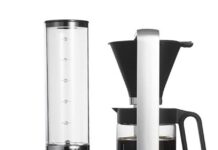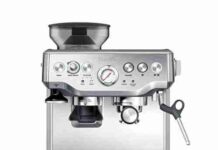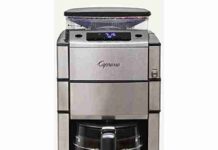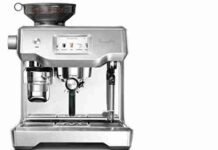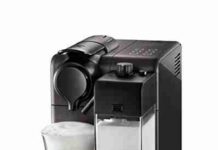In this article, we will share some effective tips on how to successfully eliminate mold from your coffee maker. We understand that dealing with mold can be a frustrating and unwelcome task, but fret not, as we have got you covered! By following these simple yet powerful methods, you can ensure that your coffee maker is sparkling clean and ready to brew your favorite cup of joe without any unpleasant surprises. So, let’s dive right in and bid farewell to that stubborn mold once and for all!
Natural Cleaning Solutions
Using Vinegar
Vinegar is a versatile and effective natural cleaning solution that can be used to remove mold in your coffee maker. The acidic nature of vinegar helps to kill mold and remove any stubborn stains or build-up. To clean your coffee maker using vinegar, simply mix equal parts of vinegar and water and pour the mixture into the water reservoir. Run a brewing cycle without adding coffee grounds, and repeat this process two to three times to ensure all traces of mold are eliminated. Remember to rinse the coffee maker thoroughly with water after cleaning to remove any vinegar residue.
Using Baking Soda
Baking soda is another excellent natural cleaner that can be used to tackle mold growth in your coffee maker. Its mild abrasive properties help to scrub away mold and stains, while its natural deodorizing properties eliminate any unpleasant odors. To clean your coffee maker with baking soda, make a paste by mixing baking soda with a small amount of water. Apply the paste to the affected areas and scrub gently using a sponge or brush. Rinse thoroughly with water to remove any residue before using the coffee maker again.
Using Lemon Juice
Lemon juice is not only refreshing in your morning cup of tea or water but can also be used as a natural cleaning agent for your coffee maker. The citric acid in lemon juice helps to break down mold and remove any lingering odors. To clean your coffee maker with lemon juice, mix equal parts of lemon juice and water and pour the mixture into the water reservoir. Run a brewing cycle without coffee grounds, and repeat the process once or twice to ensure thorough cleaning. Don’t forget to rinse the coffee maker with water afterward to eliminate any lemon juice residue.
Cleaning with Commercial Products
Using Coffee Maker Cleaner
If you prefer to use a commercial cleaner specifically designed for coffee makers, there are various coffee maker cleaners available in the market. These cleaners are formulated to remove mold, bacteria, and mineral build-up effectively. Follow the instructions provided by the manufacturer for the specific cleaner you choose to ensure safe and optimal results. Typically, you would fill the water reservoir with water and the recommended amount of cleaner, run a brewing cycle without coffee grounds, and then rinse the coffee maker with water to remove any residue.
Using Bleach-Based Cleaners
Bleach-based cleaners can also be used to clean a coffee maker and eliminate mold. However, it is important to use caution when using bleach, as it can be harmful if not handled properly. It is recommended to dilute bleach with water before using it in your coffee maker. Fill the water reservoir with the diluted bleach solution, run a brewing cycle without coffee grounds, and then thoroughly rinse the coffee maker with water. Ensure that all traces of bleach are removed before using the coffee maker again.
Using Descaling Solutions
Descaling solutions are specifically designed to remove mineral deposits and scale build-up in coffee makers. These solutions can also help in eliminating mold and bacteria. Follow the instructions provided by the manufacturer of the descaling solution to effectively clean your coffee maker. Generally, you would fill the water reservoir with the descaling solution, run a brewing cycle without coffee grounds, and then repeat the process with clean water to rinse the coffee maker thoroughly.
Deep Cleaning Methods
Cleaning the Water Reservoir
The water reservoir of your coffee maker is a prime breeding ground for mold and bacteria, as it provides the perfect environment of warmth and moisture. To deep clean the water reservoir, start by ensuring that the coffee maker is unplugged and completely cool. Remove the reservoir if possible and wash it with warm, soapy water. Pay close attention to any nooks or crannies where mold or residue may be hiding. Rinse the reservoir thoroughly and dry it before reattaching it to the coffee maker.
Cleaning the Carafe
The carafe of your coffee maker is where brewed coffee accumulates, making it susceptible to mold growth if not cleaned regularly. To clean the carafe, wash it with warm, soapy water and use a sponge or brush to scrub away any stains or residue that may be present. Rinse the carafe thoroughly to ensure all soap is removed, and dry it before placing it back in the coffee maker.
Cleaning the Filter Basket
The filter basket of your coffee maker plays a vital role in ensuring that your coffee is brewed to perfection. However, it can also collect mold, coffee grounds, and other residues, which can lead to unpleasant flavors and potential mold growth. To clean the filter basket, remove it from the coffee maker and discard any used coffee grounds. Wash the filter basket with warm, soapy water, and use a brush or sponge to remove any stubborn residue. Rinse the filter basket thoroughly before placing it back in the coffee maker.
Cleaning the Brew Head
The brew head is the component of the coffee maker where hot water is forced through the coffee grounds to brew coffee. Over time, mold and mineral deposits can accumulate in the brew head, affecting the taste and quality of your coffee. To clean the brew head, remove any detachable parts according to the manufacturer’s instructions. Use warm, soapy water and a brush or sponge to clean the brew head thoroughly, paying attention to any small crevices or openings. Rinse the brew head parts carefully to ensure all soap and debris are removed before reassembling them.
Cleaning the Heating Element
The heating element of your coffee maker provides the necessary heat to brew coffee. However, it can also accumulate mineral deposits and mold if not cleaned regularly. To clean the heating element, ensure that the coffee maker is unplugged and completely cool. Use a soft-bristle brush or a toothbrush to gently remove any loose residue or debris from the heating element. Do not use any water or cleaning agents directly on the heating element. If necessary, consult the manufacturer’s instructions or seek professional help for a more thorough cleaning of the heating element.
Maintenance Practices
Regular Cleaning Routine
Maintaining a regular cleaning routine is essential to prevent mold growth and maintain the cleanliness of your coffee maker. Set a schedule to clean your coffee maker at least once a month, or more frequently if you use it daily. Regular cleaning helps to remove accumulated mildew, mineral deposits, and other residues that can compromise the taste and quality of your coffee.
Emptying and Drying Properly
After each use, ensure that you empty the carafe and remove any used coffee grounds from the filter basket. Leaving moisture or coffee grounds in the coffee maker can create a favorable environment for mold growth. Additionally, make sure both the carafe and filter basket are thoroughly dried before reassembling them into the coffee maker.
Avoiding Stagnant Water
Leaving stagnant water in the water reservoir for extended periods can lead to mold growth and unpleasant odors. To avoid this, empty and rinse the water reservoir after each use. If you’re not planning to use the coffee maker for an extended period, empty the reservoir and let it air dry completely before storing the coffee maker.
Regular Filter Replacement
Replacing the filter in your coffee maker regularly is crucial for maintaining both the taste and hygiene of your brewed coffee. Filters can trap mold, bacteria, and other impurities, so it’s important to follow the manufacturer’s recommendations for replacing them. Using a fresh filter with each brew ensures that your coffee is not contaminated by any residual mold or debris.
Using Only Fresh Coffee
Using fresh and high-quality coffee is not only essential for a delicious brew, but it also helps to prevent mold growth in your coffee maker. Stale or expired coffee grounds can accumulate moisture and promote mold growth. Purchase coffee in smaller quantities and store it in an airtight container to maintain its freshness. Check the expiration dates on coffee packaging to ensure you are using fresh beans or grounds for the best-tasting coffee.
Preventive Measures
Proper Storage
Properly storing your coffee maker when not in use can help prevent mold growth. After cleaning and drying your coffee maker, store it in a clean and dry area, away from any potential sources of moisture. Ensure that the coffee maker is covered or stored in a place with minimal exposure to dust and dirt.
Cleaning After Each Use
Cleaning your coffee maker after each use, even if it’s just a quick rinse of the water reservoir and carafe, can help prevent mold growth. Removing any residual water and coffee grounds reduces the risk of mold and keeps your coffee maker fresh and ready for the next use.
Avoiding Leaving Coffee Sitting
Leaving brewed coffee sitting in the carafe for an extended period can promote mold growth. If you have leftover coffee, transfer it to a thermal carafe or another airtight container for storage. This prevents the coffee from being exposed to air and moisture, reducing the likelihood of mold growth.
Periodic Deep Cleaning
In addition to regular cleaning, performing a deep cleaning of your coffee maker every few months is recommended to eliminate any hidden mold or mineral deposits. Deep cleaning involves thorough cleaning of all the components, as described earlier, and ensures that your coffee maker is in its best condition.
Avoiding Overfilling
Overfilling the water reservoir of your coffee maker can lead to spillage and moisture accumulation. Ensure that you only fill the reservoir with the recommended amount of water for each brew. This helps prevent excess moisture that can promote mold growth and ensures that your coffee maker operates efficiently.
Signs of Mold in Coffee Maker
Visible Mold Growth
One of the most obvious signs of mold in a coffee maker is visible growth, typically forming in areas such as the water reservoir, carafe, or filter basket. Mold can appear as black, green, or even white spots or patches. If you notice any signs of mold growth, it’s essential to address the issue promptly to prevent further contamination.
Musty or Foul Odor
Another indication of mold in a coffee maker is a musty or foul odor coming from the machine or the brewed coffee. Mold produces volatile organic compounds (VOCs) that can result in unpleasant smells when it grows. If you detect a strong, unusual odor when using your coffee maker, it may be a sign of mold growth.
Off-Taste in Brewed Coffee
One of the clearest indications that mold has contaminated your coffee maker is an off-taste in the brewed coffee. Mold can alter the flavor of the coffee, giving it a sour or musty taste that is distinctly different from the usual aroma and flavor profile. If your coffee starts tasting strange or unpleasant, it’s important to investigate and clean your coffee maker thoroughly.
Health Risks of Mold in Coffee Maker
Respiratory Issues
Exposure to mold in a coffee maker can lead to respiratory issues, especially for individuals with pre-existing conditions such as asthma or allergies. Breathing in mold spores can irritate the lungs and airways, causing symptoms such as coughing, wheezing, and shortness of breath. Prolonged exposure to mold can exacerbate respiratory conditions and potentially lead to further complications.
Allergies
Mold is a common allergen that can trigger allergic reactions in both sensitive and non-sensitive individuals. Symptoms of mold allergies include sneezing, itching, watery eyes, and nasal congestion. If you are allergic to mold and come into contact with it through your coffee maker, it can potentially worsen your allergy symptoms.
Toxicity and Mycotoxins
Some molds produce mycotoxins, toxic substances that can be harmful if ingested or inhaled. Prolonged exposure to mycotoxins can result in various health issues, including neurological damage, immune system suppression, and organ damage. While the presence of mycotoxins in coffee makers is relatively rare, proper cleaning and maintenance are essential to minimize the risk of exposure.
Precautions and Safety Tips
Proper Ventilation
When cleaning your coffee maker, ensure that you are in a well-ventilated area to prevent inhaling any cleaning products or potential mold spores. Open windows or use exhaust fans to improve airflow and reduce the concentration of chemicals or mold in the air.
Using Protective Equipment
Wearing protective gloves and a mask while cleaning your coffee maker can help protect your skin and respiratory system from any potentially harmful chemicals or mold spores. These precautions are especially important if you are using bleach or other strong cleaning agents.
Avoiding Mixing Chemical Cleaners
Mixing different chemical cleaners can produce harmful fumes or reactions. Avoid using multiple cleaners simultaneously and always follow the instructions provided by the manufacturer. Stick to one cleaning product at a time to ensure safe and effective cleaning.
When to Seek Professional Help
Extreme Mold Growth
If your coffee maker has extensive mold growth that cannot be effectively cleaned using household methods or commercial cleaners, it may be necessary to seek professional help. Professional mold remediation specialists have the expertise and equipment to handle severe mold contamination safely and effectively.
Persistent Mold Issues
If you have repeatedly cleaned your coffee maker but the mold keeps returning, it could indicate an underlying problem. Persistent mold growth may be a sign of high humidity or moisture in your kitchen or a malfunction in your coffee maker. Consulting a professional can help identify the root cause and provide appropriate solutions.
Complex Coffee Maker Components
Some coffee makers have intricate components or internal parts that are difficult to access or clean properly. If you have a high-end or complex coffee maker, seeking professional assistance for deep cleaning can ensure that all components are thoroughly cleaned without causing damage.
Conclusion
Keeping your coffee maker clean and mold-free is crucial for both the quality of your brewed coffee and your health. By using natural cleaning solutions like vinegar, baking soda, and lemon juice, you can effectively remove mold and prevent its regrowth. Commercial coffee maker cleaners and descaling solutions are also effective options for mold removal. Regular maintenance practices, such as a cleaning routine, proper drying, and regular filter replacement, help prevent mold growth. Recognizing the signs of mold in a coffee maker and understanding the potential health risks associated with mold exposure highlights the importance of keeping your coffee maker clean. Taking necessary precautions while cleaning, ensuring proper ventilation, and using protective equipment can help maintain a safe environment. If severe mold growth, persistent issues, or complex components are encountered, seeking professional help is recommended for thorough cleaning and assessment. By following these preventive measures and taking proper care of your coffee maker, you can enjoy a delicious and mold-free cup of coffee every time.



